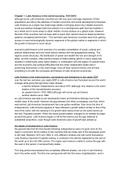Chapter 1: Latin America in the world economy, 1810-2010
although some Latin American countries are still very poor and large segments of their
populations are still on the sidelines of modern economic and social development processes,
Latin America as a region has made large strides in bringing about very notable economic,
social and political changes that have placed it on a development path that has enabled it ,
as a whole and in some areas to attain middle- income statues on a global scale. However
the bulk of the countries had not been able to leave their natural resource based production
patterns completely behind them. This had held Latin American countries back from gaining
access to more technologically dynamic segments of the global market or segments in which
the growth of demand is more robust
economic performance is the outcome of a complex constellation of social, cultural and
political relationships and how those factors interact with the geographical setting. The
regions social structures, the distribution of power and wealth the role and strength of it's
elites, and the complex, often painful process of state building (which in many cases has
resulted in endemically weak nation states)- in combination with the legacy of colonial times
and the economic and political difficulties that the newly independent states had in
positioning themselves on the world stage- have all been decisive factors and all have
something to do with the successes and failures of Latin American economies.
Latin America in the world economy: convergence and divergence in per capita GDP
over the last two centuries, per capita GDP in Latin America has fluctuated around the world
average while going through three major phases:
- a decline between independence and about 1870 (although only relative to the world
leaders of the industrialization process)
- an upward trend in 1870-1980 (although with some ups and downs
- another decline since 1980
so Latin America was able to join development early and therefore belongs now to the
middle class of the world. However the gap between the West is enlarging, and Asia, which
was behind Latin American development has now gotten wealthier. Ever since the time of
independence, Latin America appears to have followed a growth pattern similar to that of the
rest of the world, with the upswing in it's growth rates being driven by the same factors as
the rest: Population growth. When the wests growth pattern changed to ne marked by larger
productivity gains, Latin America began to fall further behind and the gap widened to
substantial proportions, even though Latin America's pace of growth also picked up
the stages of development in Latin America
the general idea that the first decade following independence were not good ones for the
region in economic terms relative to the countries that are today part of the developed world
is still valid. Between 1870 and 1980, in very different contexts and with some fluctuations,
Latin America improved it's global ranking, in contrast to the decline registered by the rest of
the world up to the mid 20th century. The region was however unable to narrow the gap with
the west in this period, it remained fairly stable.
This long period encompassed two completely different phases, not only in Latin America
but in the entire world. The first one corresponds with the first wave of globalization, and in
, Latin America, a stage in which commodity exports were expanding. This phase began to
fade during WWI, and ended with the great depression. This marked the beginning of a new
phase of Latin American development which we will refer to as the era of state led
industrialization.
SInce 1980, Latin America has not only been lagging further behind the developed
economies, but has also lost ground vis a vis the world average. All this happend against a
backdrop of deep inequalities, within the region, which were already clearly apparent as
early as the 1820s.
a typology for an analysis of the Latin American countries
certain characteristics were decisive during the colonial period but as a consequence of
economic growth, structural change and social developments since that time, new traits or
factors have taken on greater importance and capture the existing differences more clearly.
Thus one typology may be more informative in one period bur may contribute less to the
analysis of another. The Latin American countries have been shaped by the interaction of
three different societies that came together in the Americas: Indigenous people, Europeans
and Africans.
criteria for Latin American typology
- the type of colonial power
- important yet not decisive
- relevant difference is between Spanish and Portuguese colonization
- the type of market into which each society is most fully integrated
- the main type of commodity, particularly in export activities: mining, agriculture or
forestry
- specific commodities gave rise to different options fro technological
development and social organization, although this does not mean that there
is a strict deterministic correlation between the types of sources a country has
and the path that it's technological and institutional development will take.
- the different ways in which the transition is made to the kind of wage based labour
market that is typical of modern capitalist economies and that is now prevalent
throughout the region as well
- the Indo European one → where the indigenous and mestizo groups
constitute a large part of the population
- societies where african descendants have had a strong presence → Euro
African
- Euro American → southern cone where European immigration has been the
main factor of growth of the population
- size is also important
when the criteria of type of commodity and type of transition are combined a powerful
typology can be constructed that captures a large part of the conditions existing in Latin
America, especially in the early 20th century. In this time period, the incomes of the different
countries have converted and diverged as well.
convergence, divergence and integration to the world economy






